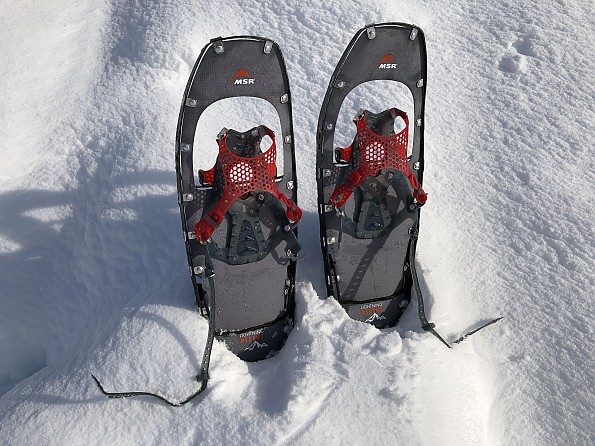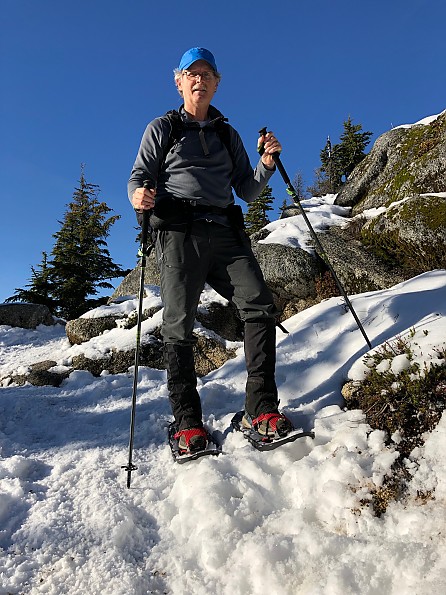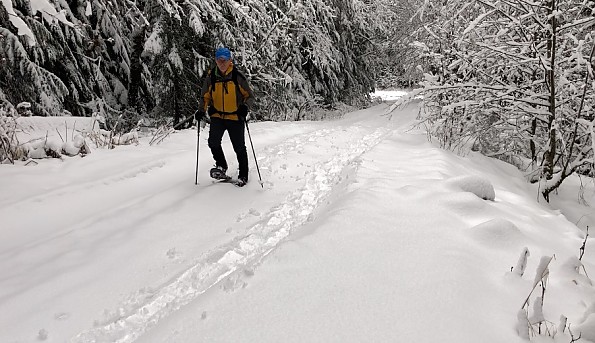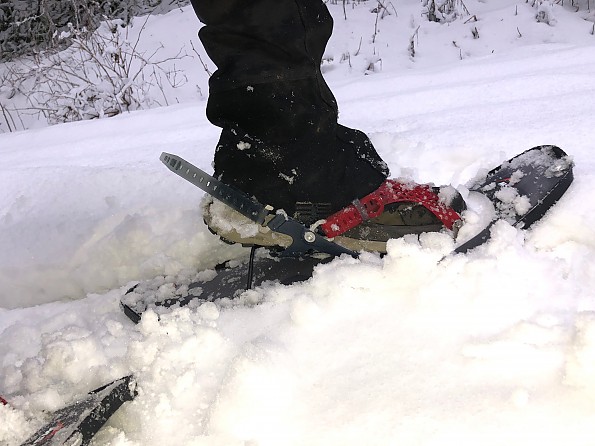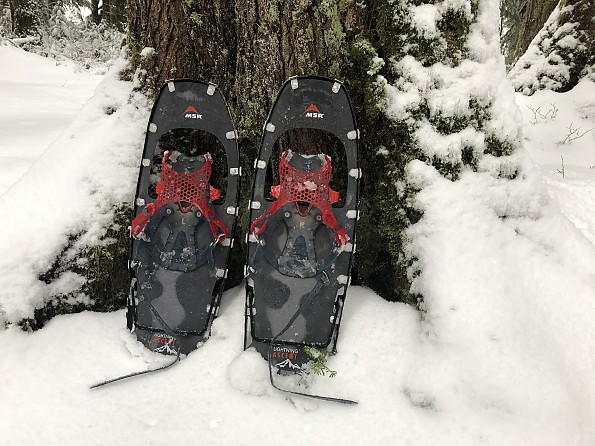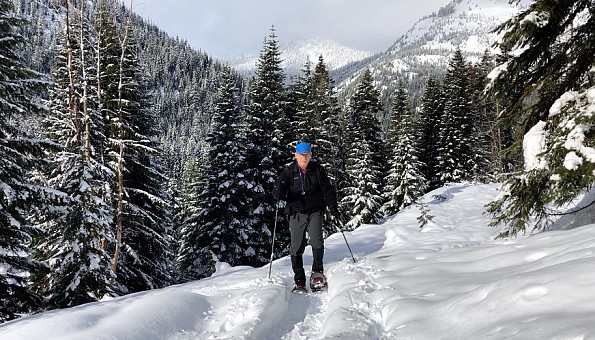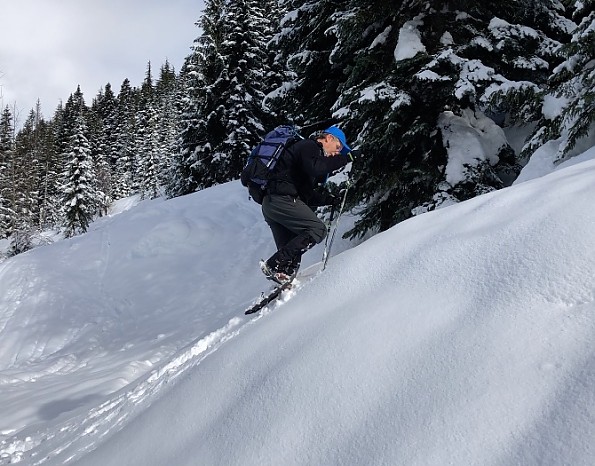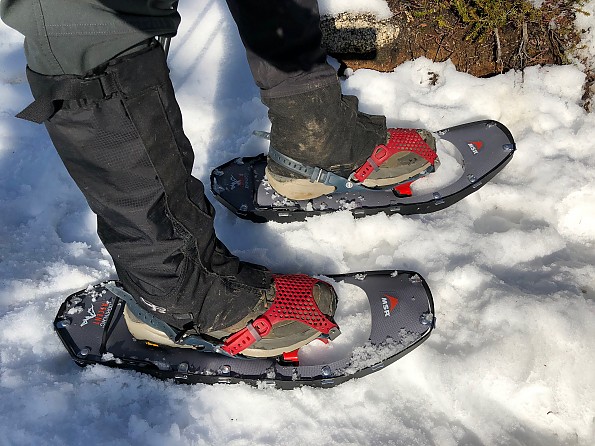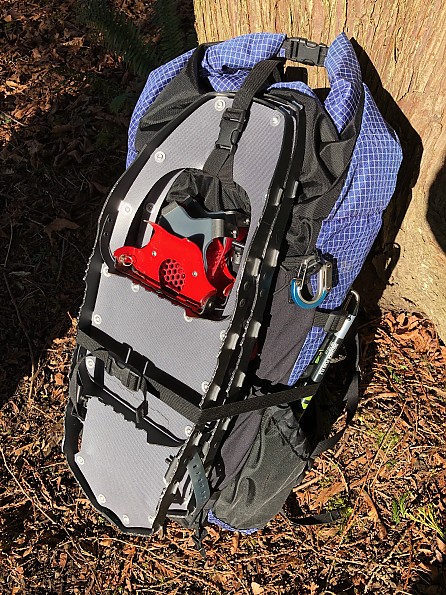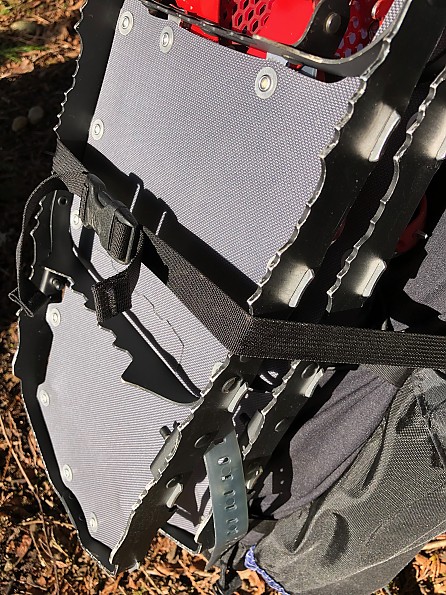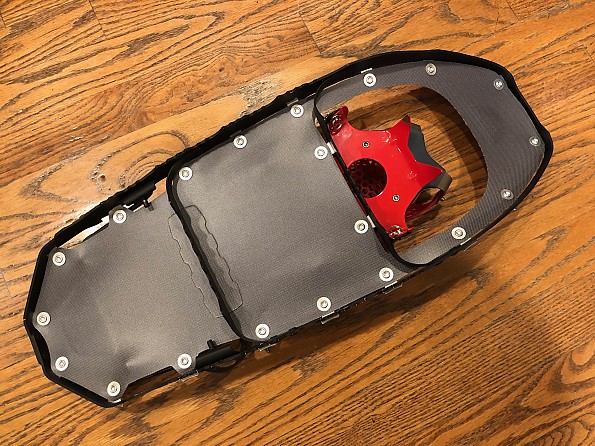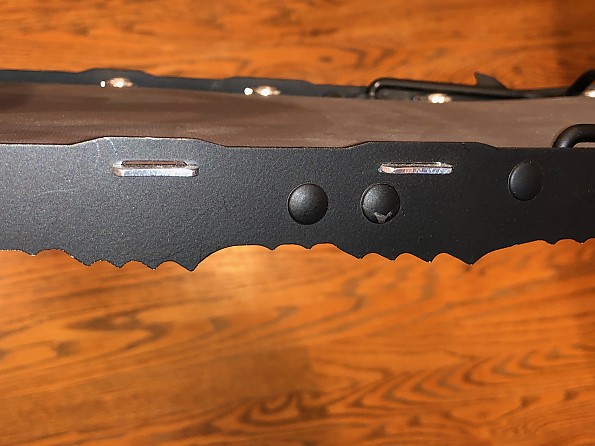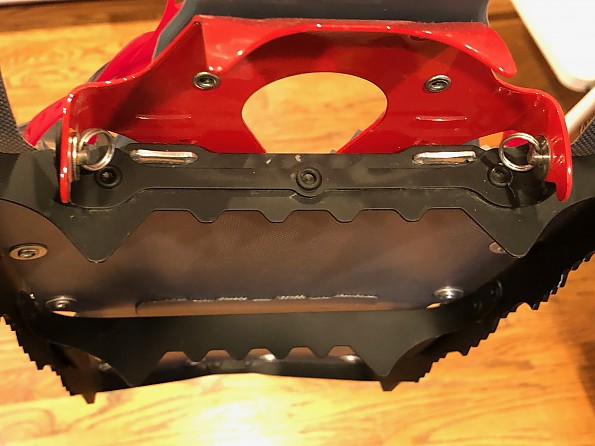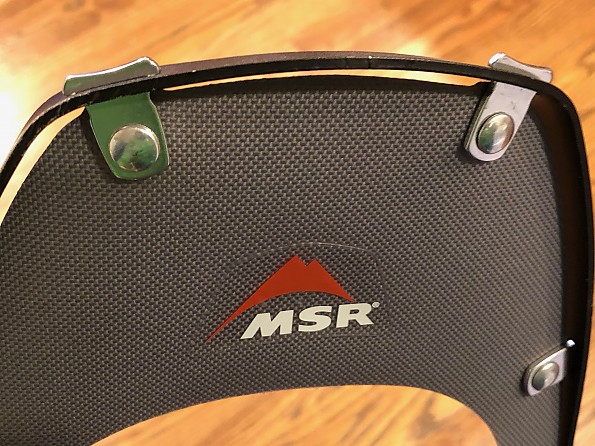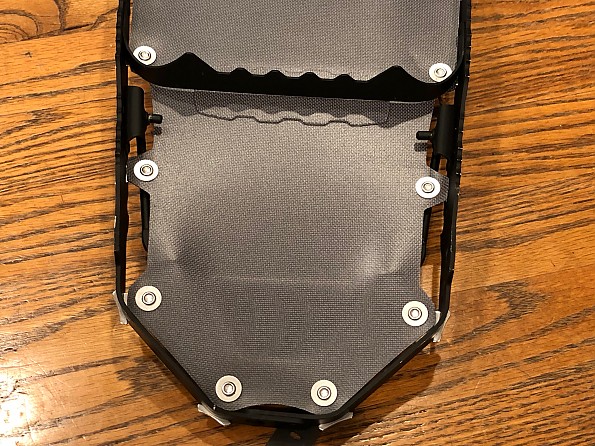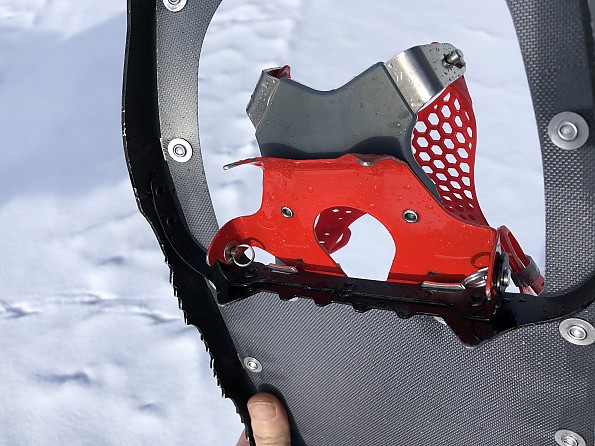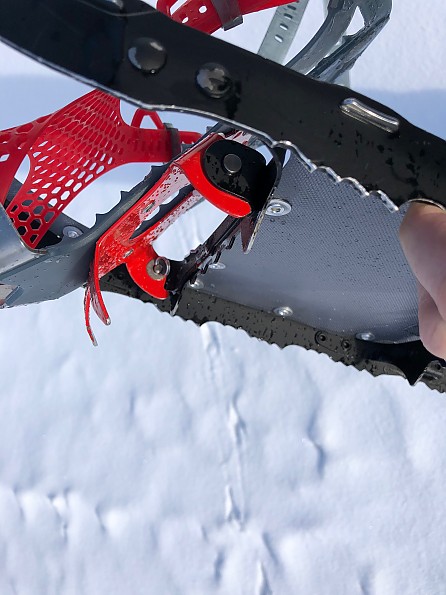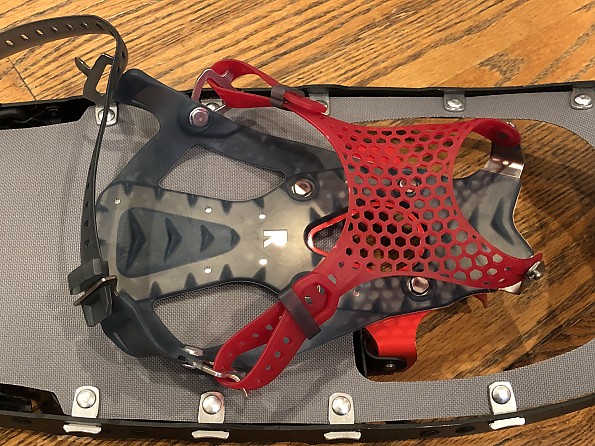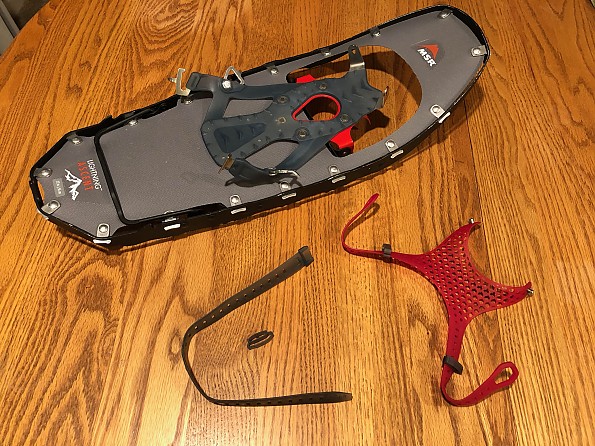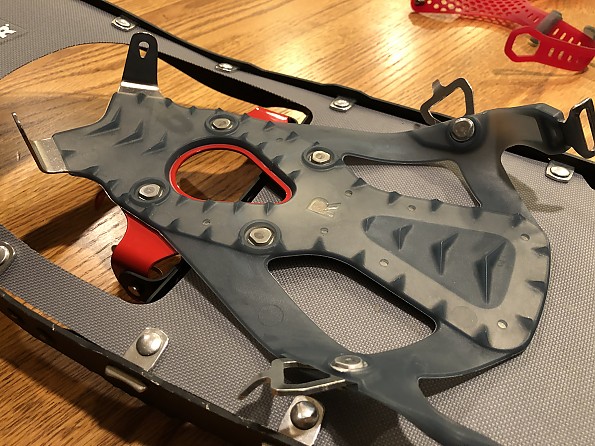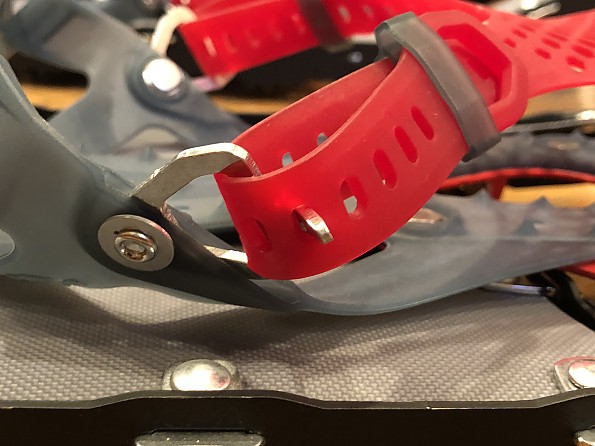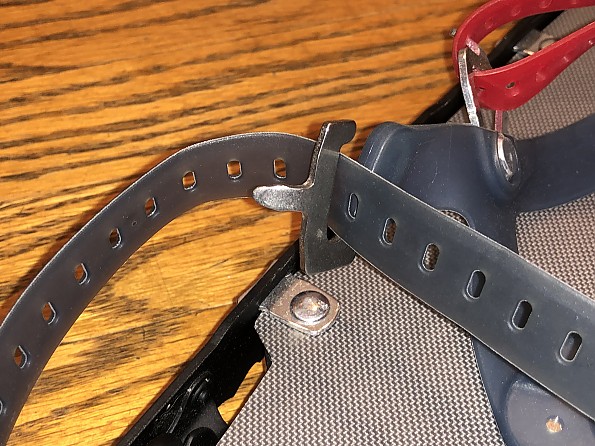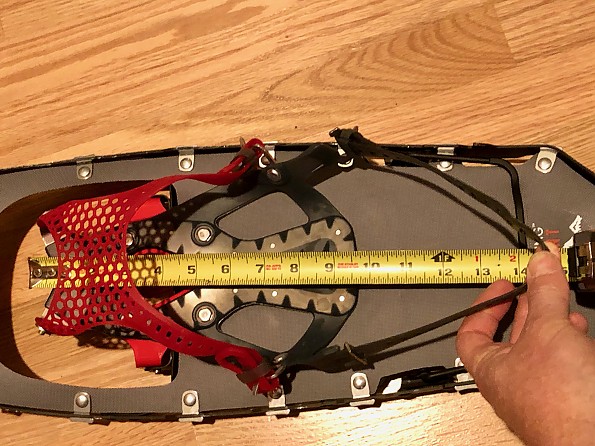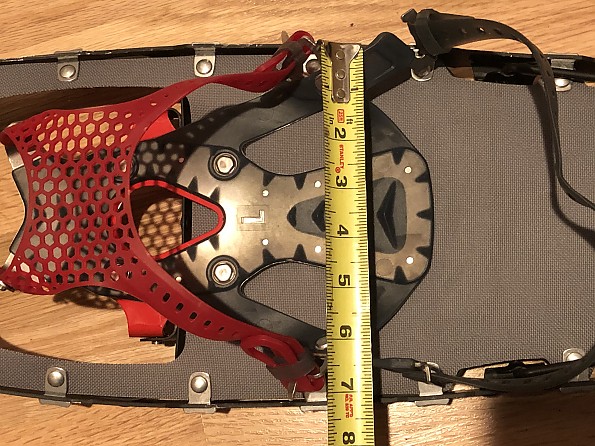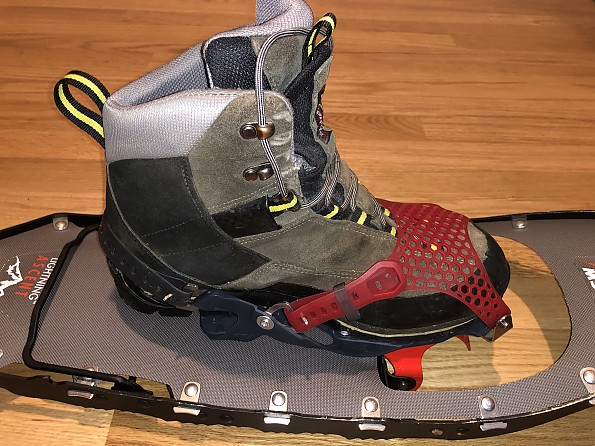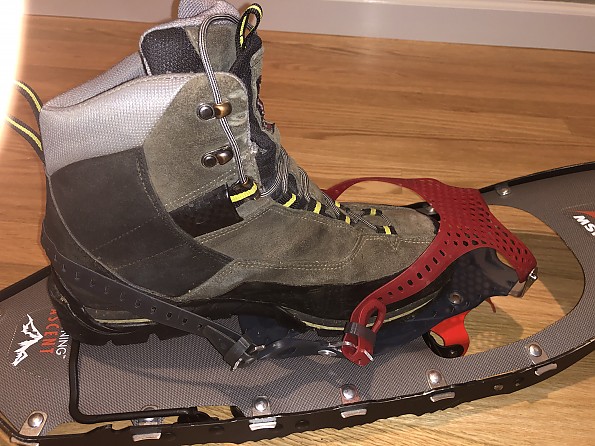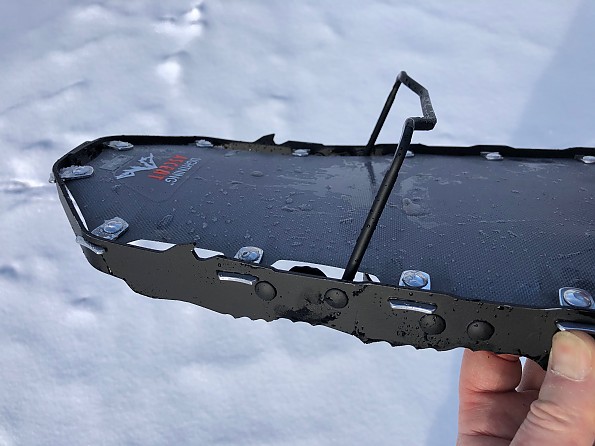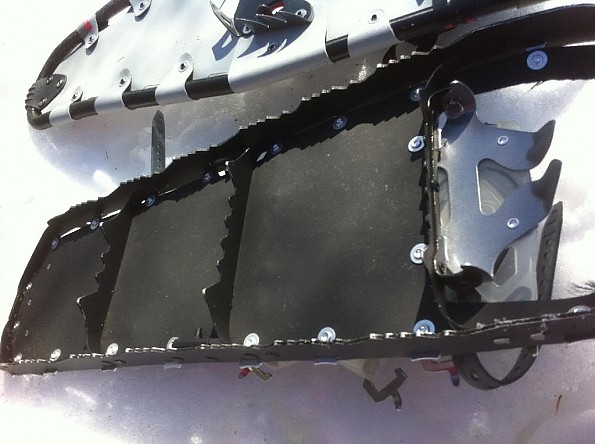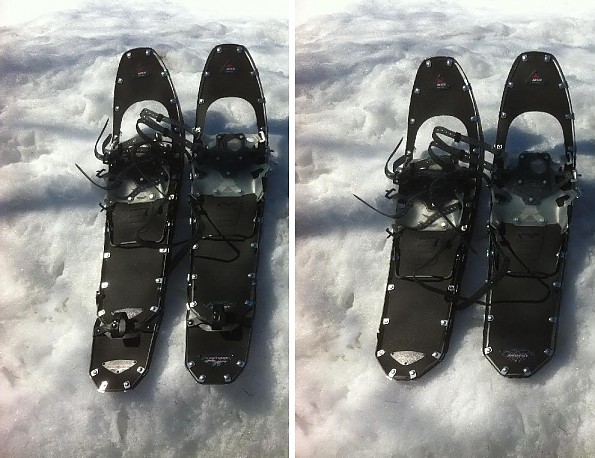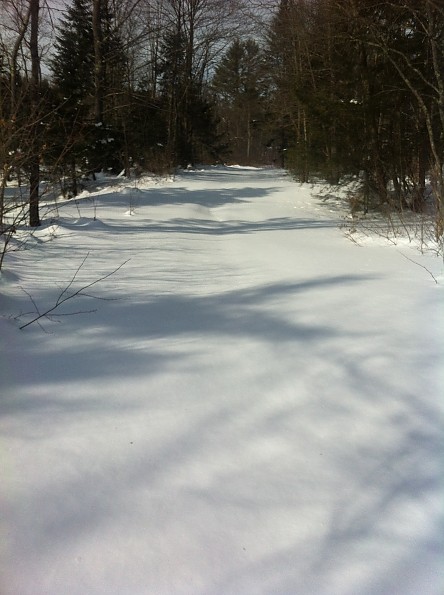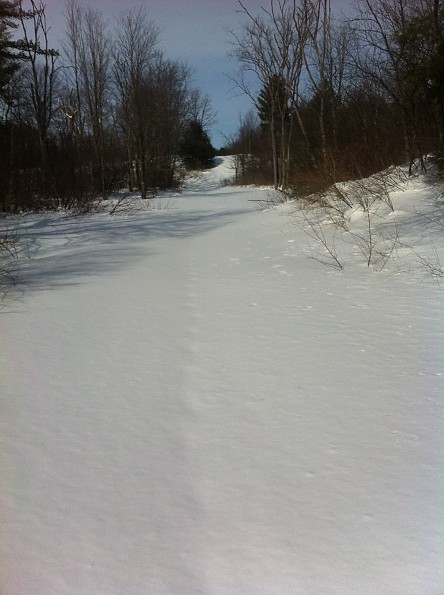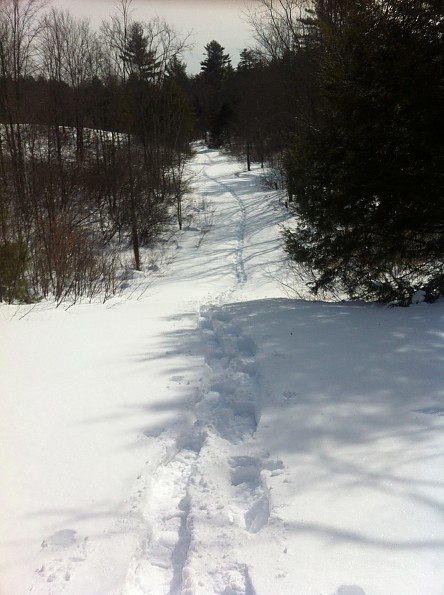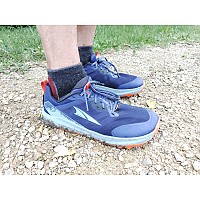MSR Lightning Ascent
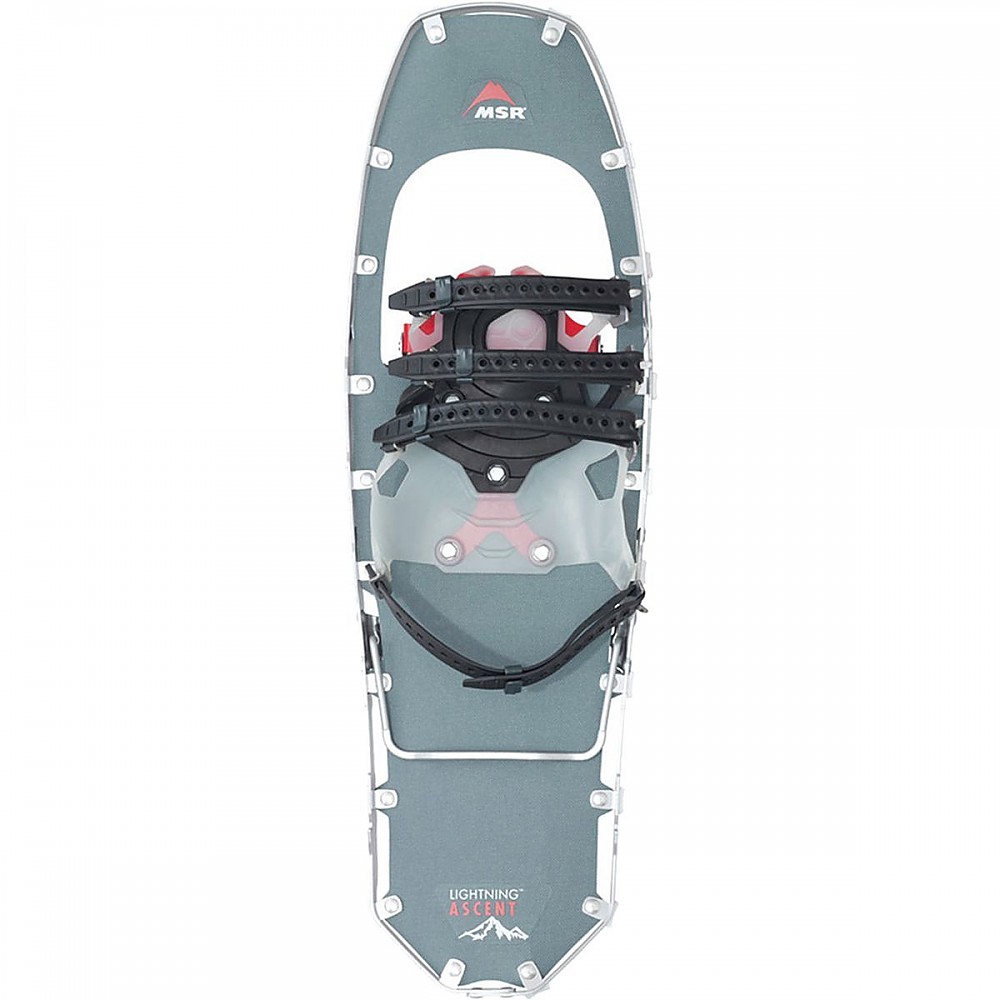
The MSR Lightning Ascent snowshoe is a very well designed go-anywhere snowshoe with a new Paragon binding design that lives up to its name. The Lightning Ascent's design has a number of aggressive features that really enable this snowshoe to be used confidently in the most challenging crusty and icy conditions. The new Paragon binding is simple to use and comfortable in use. This really is a great snowshoe option for someone looking for a durable design that can be used in any conditions.
Pros
- Simple binding adjustments
- Very aggressive traction features
- Not noisy like all-plastic deck models
- Incorporates a heel support that can be operated with a trekking/ski pole
- Tails are available for extra flotation
- Paragon binding supports a wide range of footwear sizes
- Spare binding parts are available and some are field replaceable
- Designed by a manufacture that will be around to provide support well into the future
Cons
- Decking material absorbs moisture
Overview
The MSR Lightning Ascents are positioned as MSR’s top of the line snowshoe with a focus on being an ultralight aggressive design that can be used in challenging technical terrain. The latest version of the Lightning Ascent now comes with MSR’s new Paragon binding which MSR claims to offer greater comfort and foot control.
The MSR Lightning Ascent is actually one of three models of the MSR Lightning snowshoe designs and I provide a brief comparison of the three models at the end of this review.
I would be the first to admit that I don’t have the broadest vocabulary, so when I saw the name “Paragon” I thought it sound cool, but I really didn’t know what the definition of the word was, so I looked it up. Well according to Merriam-Webster, the definition of paragon is “a model of excellence or perfection.” Based on my experience to date with MSR’s Paragon binding I wouldn’t disagree with the name they chose for the binding as it really is one of the nicest bindings I have ever used.
Prior to getting the opportunity to review this pair of MSR Lightning Ascent snowshoes, my go-to pair of snowshoes has been a pair of MSR Denalis that I have had since the '90s and I have never thought about getting another pair as the Denalis were and still are a great pair of snowshoes for the Western Washington Cascades where I do most of my snowshoeing. Now that I have used the MSR Lightning Ascents on a number of trips my Denalis probably won’t see as much use as the Lightning Ascents with the Paragon bindings are such a significant improvement that it would be hard going back to the Denalis.
I have structured this review into the three main sections listed below, followed by a summary at the end.
- My impressions to date
- Details on the Design and Construction
- Physical Characteristics
My Impressions to Date
I have had the MSR Lightning Ascents for a few months now, and while our snow came late this year, I have still been able to get out on several trips under different conditions over the last couple of months to get experience with the MSR Lightning Ascents and with the new Paragon Bindings.
On one of my trips early in the season we had finally gotten some snow, but that was followed by some rain and then colder temperatures and what we ended up with at the time was some crusty icy conditions. While the ideal traction device for this trip was really MicroSpikes, I had been carrying the MSR Lightning Ascents and loaned my MicroSpikes to another person in our party, and so I used the MSR Lightning Ascents. Due to all of the aggressive traction features which include the entire perimeter of the frame, the two aggressive cross members, and the integral crampon, the MSR Lightning Ascents really shine under these conditions.
One other nice benefit of the MSR Lightning Ascents over my beloved MSR Denali snowshoes is less noise. The MSR Denali's all-plastic deck functioned great, but on icy/crusty conditions they made a lot of noise and seem to amplify the noise made crunching the snow and ice. The aluminum frame and ballistic decking material design of the MSR Lightning Ascents don’t really generate any noise beyond the crunching of the snow and ice, so it's a nice improvement for someone like me who has been using the MSR Denalis for so long.
On another trip I was able to get out to an area where we had several inches of new snow over a foot or two of older compact snow. The trip followed a backcountry road for a few miles and involved about an 800-foot elevation gain, so I was able off and on to spend a significant amount of time on a gentle to moderate slope using the Ergo Televator heel lift integrated into the MSR Lightning Ascent.
I didn’t have any issues with the Ergo Televator heel lifts in that when they were in use they stayed up and when they were stowed away they stayed out of the way in their stowed position.
I also found that I could use the tip of my trekking pole to deploy and stow the Ergo Televators without much of an issue, which is a nice feature if you happen to be carrying a heavy pack.
As a general note, when shopping for a snowshoe I would always recommend getting a design that incorporates some sort of heel lift feature. A heel lift goes a long way in helping to reduce fatigue and stress on the knees during a long climb, so it's really a desirable feature to have.
One thing I did notice at the end of this particular trip was the decking material used on the MSR Lightning Ascents was wet. The temperate was above freezing for most of the trip, so the snow was wet, but with the color of the decking material being a light gray, the areas that had absorbed moisture stood out as being darker. While MSR doesn’t indicate the decking material is waterproof other than to state it is a TPU coated nylon, I just kind of assumed it was.
Here is a picture showing the MSR Lightning Ascents with the wet decking material.
Do I think this is an issue? Probably not. When I have been out on trips where the temperatures were below freezing the decking material never became wet, which would make sense since the snow wasn’t melting. While most of my snowshoe trips are day trips, I wonder what might happen on a multi-day trip where the decking material might get wet during the day and then freeze overnight, and whether ice forming within the decking material could adversely affect the material.
During my use of the MSR Lightning Ascents, the decking material has been wet more than once and I have not seen any adverse impacts like stretching in the material, so I don’t think this is an issue at all, but based on a suggestion by one of the other Review Corps members (Thanks, LoneStranger!) I decided to do a test.
The test I set up was pretty simple. I first would soak the tail of the snowshoe in a bucket of tap water and let it soak until I noticed the same discoloration as what I saw out in the field and then I would put the snowshoe in my freezer for several hours so that ice would form on the outside and any moisture within the decking material had time to freeze up.
Here is a picture of how I soaked the tail end of the MSR Lightning Ascent snowshoe.
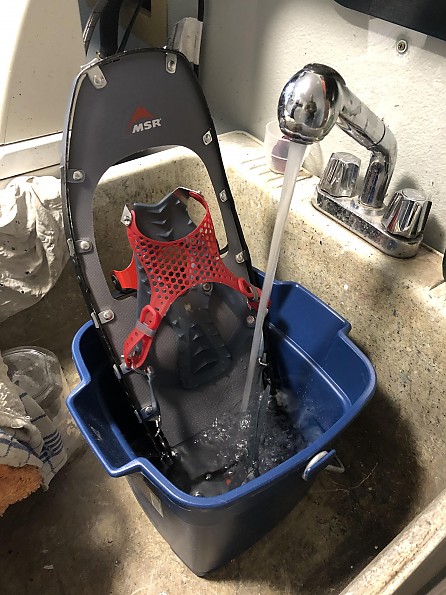
Here is a picture showing the decking material after soaking where you can see the transition near the center of the picture between the darker water soaked decking and the dry lighter gray decking.
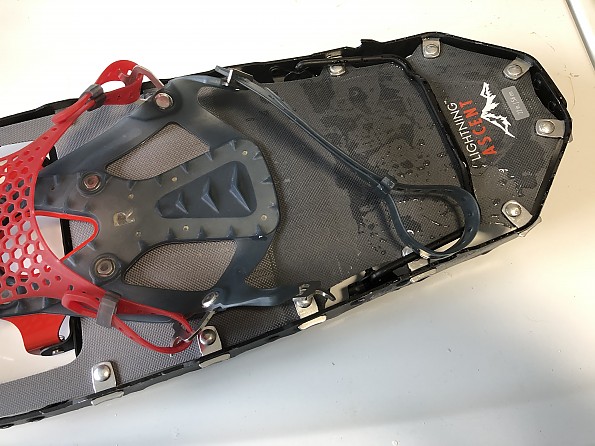 And here is a picture of the MSR Lightning Ascent snowshoe in my freezer (I'm lucky to have a very understanding wife...).
And here is a picture of the MSR Lightning Ascent snowshoe in my freezer (I'm lucky to have a very understanding wife...).
Here is a picture of what I typically saw when I removed the MSR Lightning Ascent after the cold soak in my freezer. Water drops on the surface were frozen, but I didn't sense any difference in the flexibility of the decking material compared to when it was at room temperature that would indicate any effect if there was internal icing taking place.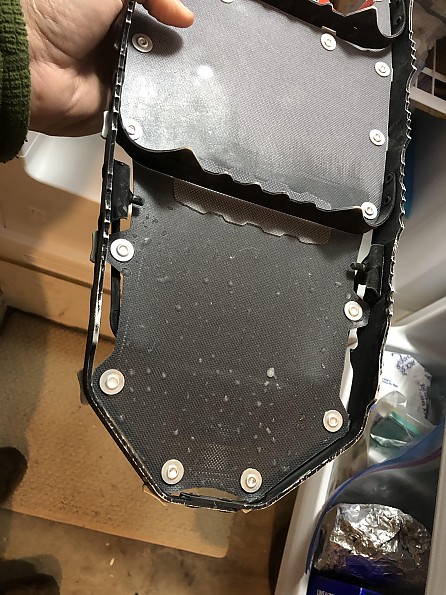
Over the period of a couple of days I did ten complete soak-freeze-thaw cycles and at the end of the testing I didn't see any change at all in the decking material, so while I didn't expect the decking material to absorb moisture, based on the testing I have done I don't think this characteristic of the MSR Lightning Ascents is detrimental in any way.
I was also able to get feedback from MSR on the moisture absorption I observed and they indicated that the nylon base scrim of the decking material does wick some moisture, but that it does not impact the performance of the decking/snowshoe in any way.
I also used the MSR Lightning Ascents at higher elevations where there was in excess of a five-foot base with about a foot of new snow.
The trail I was on in this area had an average slope of approximately 1000 feet/mile so I was able to take advantage of the Ergo Elevator heel lifts. While I spent most of my time in the trail that was already there I did try breaking trail in the fresh snow and the MSR Lightning Ascents performed well. I am using the 22-inch version, which might be short from a flotation standpoint given my 195-pound weight and generally 20-pound pack, but the majority of the time in the Western Washington Cascades the snow can be heavy and wet and a shorter snowshoe always has performed well for me.
If you're not sure what size snowshoe would be right for you, MSR does have recommendations at the tech section on their website (here is the link). For the 22-inch version of the MSR Lightning Ascent that I am evaluating MSR has a recommended load of up to 180 pounds, and with the optional removable Lightning Tails that are available the load recommendation is up to 250 pounds.
I did venture out on some steeper slopes that had about 8 to 12 inches of fresh snow to see how the MSR Lightning Ascents performed. With the rotational stops within the DTX Crampon, the MSR Lightning Ascents were easy to control as the stops prevent the tail of the snowshoe from swinging forward which enables you to control the angle of the snowshoe while climbing slopes or steeping over obstacles like a log.
I haven't yet had to do any long steep traverses yet, especially in icy conditions, to see how the MSR Lightning Ascents perform, but given my experience with the old MSR Denalis that I always felt performed well, the MSR Lightning Ascents are a much more aggressive design so I don't have any doubt that they will perform well.
My experience with the new Paragon bindings on the MSR Lightning Ascents was great. After an initial adjustment of the two straps on the front red toe cover for my boots, I have not had to go back and adjust these straps on subsequent trips. With the front toe cover adjusted, getting in and out of the MSR Lightning Ascents becomes simple and easy and just involves the single heel strap.
In use I never found any issues with the Paragon binding applying uncomfortable pressure anywhere on my boots. Initially I cranked down on the heel strap thinking the tighter the better to hold my boot within the binding, but with more experience I found that you really don’t need to overly tighten the heel strap to keep your boot secure.
For the sake of testing, I did readjust the bindings during trips to see if there were any issue and didn’t have any problems. There are loops on each strap to restrain the loose end after the strap is adjusted and these loops actually have a nice design detail that is a small detent that engages the holes in the straps so that the loops stay in the desired position so they are always where you want them to be when you go to tuck away the loose end of the strap. I did notice at colder temperatures when the strap and loop material was less compliant that the detent on the loops had more resistance when the loop was being repositioned, but it was never really an issue.
While I generally always remove my gloves when I have to do something like get into my pack or adjust a binding, I did try adjusting the bindings with the lighter weight gloves I typically wear when I am active and didn't have any issues.
The Paragon bindings are marked in the center of the foot plate with an L and an R to indicate a right or left snowshoe. If you wear the MSR Lightning Ascents as indicated by the L and R guidance then the buckle for the heel strap will always be to the inside. I wore the snowshoes with the heel straps to both the outside and inside and never noticed any difference and have a slight preference when tightening the heel straps to have them on the outside location.
As a general observation, I didn't have any snow balling up or clumping under the DTX Crampon or any other part of the MSR Lightning Ascent frame. The DTX Crampon does have a red coating that may help prevent snow from adhering to the crampon, but to date on the trips I have been on this has not been an issue. Since balling or clumping of snow can be very dependent on snow conditions, if I do notice this on future trips I will come back and revise this review.
One other point worth mentioning is how the MSR Lightning Ascents stow on your pack. I've packed the MSR Lightning Ascents several times on my ULA Circuit and find that the snowshoes nest well one on top of the other; the Paragon binding is compliant and compresses nicely.
Here is a picture of the MSR Lightning Ascents attached to my pack.
As shown above, to secure the MSR Lightning Ascents to my pack I looped a strap that crosses over the top of my pack through the toe opening of the snowshoe which worked well. I also used a strap going around the back of my pack to clamp the snowshoes against my pack. There is a potential issue with the second strap as there are teeth along the back half of the side rails where this strap crosses, and with use the teeth on my MSR Lightning Ascents are starting to show a little wear and have tiny burrs which could potentially damage the lightweight straps used on my ULA Circuit. On future trips I will pad these areas, but it is something to be aware of when securing the MSR Lightning Ascents to your pack.
Here is a picture showing this in more detail.
Design and Construction
The MSR Lightning Ascent is a very light and extremely aggressive snowshoe design that is capable of taking you into just about any terrain you would venture into on snowshoes.
The basic design consists of a wraparound frame made from 7075-T6 Aluminum that also has two integral steel cross bars that are all riveted together to form a single assembly. Here is a bottom view of snowshoe showing the basic construction.
Around the perimeter of the frame and on each of the cross bars are teeth of various sizes and shapes that enable the MSR Lightning Ascents to have very aggressive traction capability in all directions.
Here are some detail photos of the teeth found on the frame and crossbars:
The top deck of the MSR Lightning Ascents is a ballistic-grade TPU coated nylon material that is attached to the perimeter of the frame by “T” shaped tabs that fit through slots in the frame and are riveted to the ballistic-grade deck material.
MSR has paid attention to details with the MSR Lightning Ascents and added a reinforcing layer to the decking material over the rear crossbar that the heel of your boot rests on and would be an obvious point for wear.
The binding assembly of the MSR Lightning Ascent is made up of a steel DTX Crampon (DTX = Durable TracXion) that is riveted to an upper plate that is molded into the lower half of the Paragon binding.
The binding is attached to the main frame of the snowshoe by two simple pins which are secured by spiral retaining rings.
One nice design detail with how the DTX Crampon interfaces with the frame of the snowshoe is that there are small tabs on the crampon that limit how far the binding can rotate with respect to the frame (approximately 70 degrees). This feature keeps the tail or the snowshoe from ever rotating forward under your foot and dragging while walking and really enables the user to control the snowshoe when stepping over obstacles like a log.
The current generation of the MSR Lightning Ascent snowshoes now utilize MSR’s new Paragon Binding which is now available on both the MSR Lightning Ascent and Revo Ascent snowshoe models.
The Paragon binding is different than many other snowshoe bindings in that the binding is designed to wrap around your boot and avoid any pressure points. The Paragon binding accomplishes this by utilizing mesh toe covers that distributes the load over toe/fore foot area and that is tensioned by inner and outer side straps. I found this approach very effective in that I didn't experience any discomfort even though I was wearing a lighter weight boot, but still maintained good control of the snowshoe while in use.
The Paragon binding is composed of three basic components: a baseplate/crampon assembly, a fore foot /toe cover, and a heel strap. At face value it seems like a very simple design, and it is, but sometimes the simplest designs require a lot of development and you can learn more about MSR’s effort to develop the Paragon binding here at this link.
The Paragon binding is also very easy to repair as the basic components all can be removed without any tools as shown below. The heel strap and toe cover also can be purchased from MSR and carried as spares on more serious trips where you would want to be able to repair a snowshoe if it had a failure.
The baseplate assembly is composed of a steel plate that is molded into the lower binding which contains all of the buckles to attach the straps from the other two binding components. The base plate is riveted to the crampon which is what attaches the binding to the base structure of the snowshoe through two pins and retaining rings.
The baseplate is textured on its upper surface with a number of aggressive pyramid type features as shown in the photo below that do a great job in helping to prevent your boot from sliding out of the binding. I found the pyramid features effective enough that with the boots I was wearing I didn’t have to crank down on the binding straps to keep my boots secure.
The straps on the fore foot/toe cover are attached to the base assembly by passing through a metal bracket that has a pin feature that engages holes in the strap at the desired position. The heel strap uses a similar arrangement, except that the metal bracket is “U” shaped and open on the upper end so that you don’t have to thread the heel strap through the bracket which makes getting in and out of the binding very easy in actual use.
The Paragon binding is a one-size-fits-all design that I think should fit just about anyone interested in the MSR Lightning Ascent snowshoes. For reference, I adjusted the Paragon bindings to their largest position and took the two photos below so you have a rough idea of what you have to work with if you happen to have a very large size boot you would like to use with this binding.
For another size reference, the two pictures below are one of my men's 10-1/2 Raichle mountaineering boots with the Paragon binding adjusted to a normal fit and then one where the boot is in the binding adjusted to its maximum size so you can see the additional space available to fit a larger boot.
For an example of the smaller end of the footwear size range that the Paragon binding will accept, I have included the two photos below of one of my wife's Merrell Chameleon Arc Mid's women hiking boot size 8.
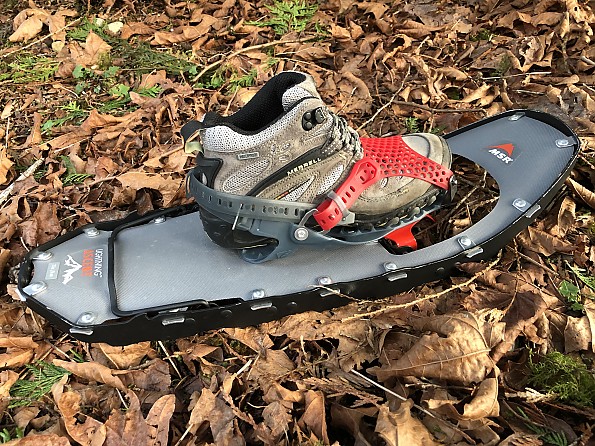
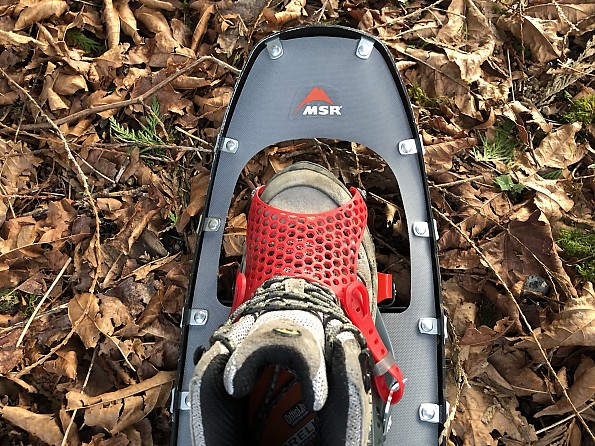 I think if you tried to use footwear smaller then my wife's boot shown above you might get into the situation where the red toe cover of the Paragon binding would not equally distribute the load from the binding over the front of your boot and it would act more as a strap over the instep of the boot.
I think if you tried to use footwear smaller then my wife's boot shown above you might get into the situation where the red toe cover of the Paragon binding would not equally distribute the load from the binding over the front of your boot and it would act more as a strap over the instep of the boot.
One of the other key features of the MSR Lightning Ascents are the Ergo Televator heel lifts incorporated into the frame of the snowshoe. The Ergo Televator is a simple steel wire feature that provides approximately 2 1/4 inches of heel lift that is really beneficial when climbing a long slope.
The Ergo Televator is designed so that when it is deployed in the lift position, it is leaning forward so that any downward force from your heel helps keep it locked in place and doesn't risk collapsing the Ergo Televator back down in its stowed position. Another nice feature is that there is a 2-1/2 inch jog along the top of the Ergo Televator that helps keep your heel centered while using the lift. The jog feature also helps enables you to raise or lower the Ergo Televator using your ski pole (with a little work…).
The bracket that attaches the Ergo Televator to the frame of the snowshoe has detent features so that the Ergo Televator stays in either the stowed or lifted positions.
It’s also worth pointing out the two sharp hook features on the top edge of the frame towards the rear of the snowshoe shown in the picture above. These features are part of the system used to retain the optional Lightning Tail assemblies (available for $59.95) that add an additional five inches in length to the snowshoe for more flotation.
Physical Characteristics of the MSR Lightning Ascents
Weight:
The weight of my 22-inch version of the MSR Lightning Ascents is 2 lbs 0.5 ounces per shoe for a total pair weight of 4 lbs 1 ounce, which is slightly under the 4 lbs 2 ounce MSR published weight.
Physical Size:
The length and width of my pair of MSR lightning Ascents was right in line with the MSR published dimensions of 22-inch length and 8-inch width. MSR also offers a 25- and 30-inch length model for greater flotation.
The toe or leading edge of the MSR lightning Ascents rises approximately 2-3/4 inches above the main deck of the snowshoe and the heel also rises approximately 3/4 of an inch above the main deck,
MSR also offers a women’s model that is approximately 3/4 of an inch narrower in width that is an option for individuals interested in a slightly narrower design.
Price:
The list price of the MSR Lightning Ascents with the Paragon Bindings is $319.95, which isn’t cheap, but if you are going to be snowshoeing in areas that are in difficult terrain and far off the beaten path where you can’t afford to have something go wrong, then this is a very fair price. Also, given how durable the design is, it will most likely last as long as you'll ever be snowshoeing, which further helps justify the upfront investment.
Summary and Recommendation
The MSR Lightning Ascents with the new Paragon bindings are great snowshoes for someone whose adventures may take them far off the beaten path into challenging conditions/icy terrain where this robust aggressive design will perform in any conditions you might encounter. The new Paragon binding really does live up to its name and sets the standard for an easy to use, comfortable, and secure binding. The MSR Lightning Ascents with the Paragon binding exemplifies the no-nonsense, robust designs that MSR has always been known for.
Many thanks to both Trailspace and MSR for the opportunity to evaluate and test the MSR Lightning Ascents with Paragon Bindings for the Trailspace Gear Review Corps!
Differences between the MSR Lightning series of snowshoe designs
As a side note I thought it might be helpful to provide brief descriptions of the differences between the three snowshoes designs available in the MSR Lightning series.
Lightning Ascent: This is MSR’s most aggressive all-terrain snowshoe and features a frame design that offers 360-degree traction combined with the steel DTX crampon which is the most aggressive of the three models. The Ascent incorporates the Ergo Televator heel lift and now has the new Paragon binding which is a very comfortable and secure binding that accepts a very wide range of boot sizes. The Ascent comes in three sizes (22-inch, 25-inch, and 30-inch) for men and two sizes (22-inch and 25-inch) for women, and also accepts an optional five-inch tail for additional flotation. The Ascent is the heaviest of the three designs and weighs 4 lbs 2 oz for the 22-inch size.
Lightning Explore: The Explore shares the same aggressive frame with 360-degree traction as the Ascent and also has the same Ergo Televator heel lift, but utilizes the HyperLink two strap binding and crampon that offers easy entry. The Explore comes in the same three lengths for men (22-inch, 25-inch, and 30-inch) and two lengths for women (22-inch and 25-inch) as the Ascent and also can accept the optional five-inch tail for additional flotation. The weight of the Explore is in between the Ascent and the Trail at 3 lbs 12 oz for a pair of the 22-inch size.
Lightning Trail: The Trail incorporates the same basic frame design as the Ascent and Explore, but with less aggressive features with a focus on being a more streamlined design. The Trail does not have a heel lift and is designed for more rolling terrain and incorporates the DuoFit strap style binding. The Trail only comes in two sizes (22-inch and 25-inch) in both men's and women's, but still can accept an optional five-inch tail for additional flotation. The Trail is the lightest of the three designs and weighs 3 lbs 3 oz for the 22-inch size.
Background
I have had the MSR Lightning Ascents for several months and have used them on several trips this season in the Western Washington Cascades. Prior to testing the MSR Lightning Ascents, my go-to pair and deeply loved snowshoes have been a pair of MSR Denalis that I have been using on trips since the '90s.
Source: received for testing via the Trailspace Review Corps
(Sample for testing and review provided by MSR)
The MSR Lightning Ascent has the best traction of any snowshoe I've used. The bindings are super secure, easy to use while wearing gloves or mittens, and won't absorb water and freeze. Their narrow width makes walking very easy, and the optional tail extensions increase flotation if you're carrying a heavier pack or are in softer snow.
Pros
- Traction
- Bindings
- Stackability
- Field maintainable
- Plain colors
- Ergo Televators
Cons
- Foremost buckle can tear decking
- Nose-down attitude with tails on
I bought my MSR Lightning Ascent 30s in early March of 2014 as a guarantee that I'd have a pair for a weekend of snowshoeing some friends and I had planned, in case the different brand of backcountry snowshoes I'd also ordered didn't make it in time. Both sets showed up on time, so I brought both sets along and gave them both a bit of a workout.
If there's one thing that makes the Lightning Ascents stand out from every other brand of snowshoe I've ever used, it's their traction. Uphill, downhill, side slopes, hard packed snow or mashed potatoes, you name it, these things stick! Here's why:
As you can see, there are two large independent toe crampons, and three lateral toothed braking/traction bars under the deck. But what's most noteworthy is how the frame itself is toothed to provide traction. MSR calls this the "360 Degree Traction Frame" and it pretty nearly lets you climb vertical slopes. I simply could not believe how much more traction these have when compared to tube-framed snowshoes.
The drawback is that the frame itself doesn't provide flotation like a tube frame does, but deep powder isn't what the Lightning Ascent was designed for. These are meant more for steep terrain with more packed snow and ice.
You will sink more wearing these in soft snow than you will with an equivalent tube-framed model. It's not unmanageable, but it is noticeable. MSR's solution was to make "tails" that attach to the rear of the frame and increase surface area for improved flotation. Here's a pic of my snowshoes with the tails attached and detached:
The tails are 5" long, attach quickly, and bring the carrying capacity up to 300+lb. However, on rolling terrain you'll notice that your toes still sink while the rear of the shoes float better. I think this is because how close to the turned-up front of the 'shoes the binding is - there's simply not much decking in contact with the ground up front. On ascents your weight transfers rearward, and you're kicking the toes in anyway. When descending it feels like the foremost traction bar has a little more weight on it.
The bindings on the Lightning Ascents are simple to use, but since there are 4 individual straps per snowshoe it'll take you a little longer to get everything tightened up. The 2 front straps are 12" long and the others are 14", which is long enough to fit over some pretty big boots. 18" straps are available if needed. The buckles have fixed pins that you push through holes in the strap, and use plastic clips to hold the free ends of the straps.
I've found that the clips secure the straps better if the open ends face forward (for the forefoot straps) or down (for the heel strap.) I have to admit that at first glance the bindings looked a little cheesy when compared to those of other snowshoes I've used, but it didn't take long for my mind to be changed. I think their strongest point is that they allow you to tailor the fit to any boot — with four 18" straps Andre the Giant could probably fit in these things.
Other than the nose-down attitude with tails attached that I mentioned earlier, the only con I've noticed is that the foremost buckle can nick the decking. MSR is aware of this and says it happens with certain styles of boots, and that it'll only go so far and stop. My Sorel Conquests are apparently one of those styles, and what I did to fix it was trim the decking with a razor blade so the buckle would clear it then seal the edge with a lighter. They're working on a new design and will replace affected snowshoes under warranty, according to an email reply I got from them.
Some of my plans for this winter include snowshoeing at least one of the following mountains in N.H. — Chocorua, Kearsarge, and Monadnock — and I'll definitely be using my MSR Lightning Ascents. With their superior traction, Ergo Televators to make the uphills easier, and simple, rugged construction, I know they'll get me up and back with no problems.
Update: 03-03-15
I've had these snowshoes for a year now, and have used them almost exclusively this winter due to a knee injury that makes it difficult to get my Tubbs Mountaineer 36s on and off (I have to kneel on and push myself up with my injured knee.)
Surprisingly to me, I found the Lightning Ascents do just as well in deep powder and unpacked snow as the much bigger Mountaineers do. While I may sink another couple inches due to the smaller surface area, there's also less surface area & weight to lift OUT of the snow. On average I've been finding myself sinking 6-8 inches lately, and maybe 12-14 inches when we first started getting heavy snow, simply because it hadn't consolidated and was fluffy down to ground level.
Last year at this time the snow was well-consolidated so I didn't sink more than a couple inches with either 'shoe. As anyone in Maine or most of New England knows, this year we've gotten nothing but light, fluffy snow, which hasn't consolidated yet, or even crusted over in most places. Even now I find myself sinking knee-deep in voids next to shrubs and bushes, and getting out is easier with the Lightning Ascents.
The MSR bindings are also more comfortable than the Tubbs. With 3 straps that go over the forefoot, you can adjust each one independently for the greatest comfort. The Tubbs bindings hold just as securely, but in order to get the V-shaped straps tight over your toes you have to pull them tight over the instep, and if you prefer your insteps a little loose then your toes will be loose as well. With a more rigid boot than my Sorel Conquests, such as stiff leather mountaineering boots or double boots, this may not be an issue. It may not be an issue with people who don't have wide forefeet but are average/below average width elsewhere, which is my case.
I haven't been able to climb any of the mountains I wanted due to my knee injury, but that hasn't kept me from getting out for a few hours at least twice per week. However, snowshoeing has done more to help my knee heal than anything else I've tried so far, so maybe before the snow is gone I'll be able to hit one of them!
Here are some of the places I've been fortunate enough to find this winter, right here in and around town no less. Look at that pristine (or nearly so) snow! The Lightning Ascents performed flawlessly here, and have become my go-to snowshoes.
Source: bought it new
Price Paid: $300
MSR Lightning Ascent 30” snowshoes, a very good snowshoe with some unique features.
Pros
- Grip
- Secure binding
- Heel lift
Cons
- Grip
- Plastic strap clip
MSR Lightning Ascent 30" snowshoes
Period of use: 1½ winters.
For a 30" snowshoe it seems to have typical 30" snowshoe floatation. :-)
It is about average in weight and has a narrow shape which makes for a nice walking stride with minimal metal to metal hits. I do prefer a snowshoe with a higher “round-up” in the nose of the snowshoe.
The pair I have is quiet, with minimal creeks and squeaks. Durability seems great, a slight loss of black paint here and there and one of the plastic strap clips broke. I have just ordered a MSR snowshoe repair kit ($15) that includes a bunch of pins, nuts, washers and a few replacement plastic strap clips.
The 5" tail extenders have been somewhat disappointing, I did not feel like it improved the floatation to that of a 36" snowshoe. But they do attach easily and never came loose.
The Lightning Ascents have very good maneuverability and excellent “side-hilling” control.
The MSR snowshoe binding has four straps, with three across the front and one around the heel. It’s easy enough to strap into and it makes a very secure hold to the boot that goes all day without loosening. Though the binding strap ends do tend to come loose and flop around a bit (not a deal breaker).
The traction is at the top of all the snowshoes I have used. Sometimes the extreme grip around the circumference of the snowshoe creates a little more drag than I like. In wet packy snow I will sometimes pickup snow clods in the bottom of the shoe.
I don’t use it a lot, but the ascent heel bail works like a charm and is a useful feature on the very steep trails.
Great engineering and American made!
The MSR Lightning Ascents are my choice when the snow has settled some, there is going to be a bunch of icy going, or the terrain has some very steep stretches.
Source: bought it new
Price Paid: $170
Just to address the concerns expressed by the top reviewer here; I work in an outdoor gear shop, and have been to training with various snowshoe reps, including MSR. It sounds as though the shoes he was reviewing are actually the Lightning Axis, a new shoe by MSR this year.
The Axis shoes have a new binding that mimics the old bike pedals from the 80s (ish). They are designed to be set at home, and not to be adjusted again, unless you change boots. I would not be surprised if these bindings need some work, given they are new this year. The 3 attachment points listed include the removable instep attachment. It is removable, which to me, means more margin for it falling off in the field. I don't know that I would buy the Lightning Axis this year - give MSR sometime to really develop the product.
MSR did remodify the bindings for the Lightning Ascents, however they are very, very similar to the old ones. These have 4 straps, 3 over the toe/instep and one around the heal. Compared to the old models, the three toe/instep straps move independently, whereas the old models were all attached to the same large piece of "stretch rubber" under the foot.
This is great, in my opinion. Gives a more custom fit, and easier to keep track of what strap goes where. The other big change is the metal nubs that catch the straps once they've been tightened. I guess this used to be plastic - the metal is nice. It's flush to the bottom of the strap, so they don't dig into your foot or boot, and the metal is beefier and much less likely to break.
The only thing I wish these did better were crampons. Not to say that these aren't awesome - they are much better than any other metal framed snowshoes out there, in my opinion. However to look at the MSR Evo Ascents, and note the agressiveness of those crampons and siderails, I wish they were able to bring some of that agressiveness to the Lightnings.
But overall, awesome shoe. I recommend it to many who come into the shop looking for a versatile snoshow that can make it up some really steep stuff.
This is a very durable and versatile piece of equipment. I’ve had a lot of fun and exploration on this reliable snowshoe.
Pros
- Flotation and traction with my MSR Lightning Ascents pushes me to greater challenges. I’ve toured in them, run in them, scaled steep icy slopes, and (somewhat) floated through powder in them.
Cons
- The tails don’t clip on as securely as they could; I run a couple of zip ties on each snowshoe to keep them more secure.
- No MSR snowshoe bag available for this size, had to go with one from MEC (which easily accommodates the tails being left on and collapsed MSR poles).
- Been carrying the MSR repair kit for two years and haven’t had to use it ;)
- They bend a bit when you take an unexpected 8' drop off a tree crossing a river. Doesn’t affect usefulness. Not advisable btw.
I’m the guy that uses and abuses equipment. My MSR Lightning Ascents have been subjected to all kinds of terrain, situations, and temperatures. I’ve jumped off ledges into deep snow, crossed riverbeds on fallen trees, taken great pleasure walking over drifted in vehicles, fences, and the occasional bungalow...any opportunity for adventure suffices.
Strolling along packed (and often icy) trails are a breeze. They eat powder up, tackle stupidly steep slopes, have proven worthy in some impromptu races, and encourage you to try challenges outside your comfort zone. My wife and I often wander up stream beds that are difficult to access during summer months and have appreciated
I’ve been able to strap my 3-pin Alico Ski March XC ski boot in them with no issues. The four rubber straps (three across the front, one across the heel) allow for a variety of footwear (the aforementioned ski boots, Insulated Vibram FiveToe Trek Ascents when it’s warmer, a variety of winter boots...). I’ve yet to have an issue using the rubber straps in any temperature and typically leave the three across the front at the same setting and ‘step in, step out’ by releasing/tightening the heel strap.
If it’s warm out and the snow is sticking I spray them with a little silicone. Works like a charm at reducing snow and ice buildup.
When I’m using the tails I’ve found the best flotation is achieved when I lean back (put more weight on my heels, typically with a light backpack), or with a more heavily loaded pack (skis attached, extra clothing) requiring no lean at all.
Background
I’ve had a variety of experience in winter adventuring—snowshoes, skis, snowball fights, bonfires in the snow, I’ve experienced it all :)
Source: received it as a personal gift
I bought the 30" Lightning Ascent 'shoes after sliding on a steep Nevada slope in my Atlas 'shoes and injuring my shoulder. The Ascents are THE grippiest 'shoes on the planet. No more sliding on the steeps. I got 30" 'shoes because I want max flotation. I'm a backcountry skier and 30" is nothing for me to manipulate when compared to skis.
Pros
- GREAT grip in all directions, especially laterally
- Decently light considering the strength and grip
- Nice flip-up heel supports for steep ascents
- Very tough sheet material
- Frame is virtually bullet proof
- Good tail extensions available (newer models, after 2010) and easy to attach
Cons
- Binding straps need a more positive, secure buckle.
- Flip-up heel elevators need more secure locking (seems to have been corrected in 2011 models).
The original Lightning Ascents (LA) I have aren't compatible with the newer tail extension-adaptable models, but I'll grind slots in the bottom edges and put small stainless steel bolts in the sides to accommodate the new tail extensions. There are not too many pieces of equipment I can't successfully modify. (Modification done, works well and is at least as strong as the new model that is made for the extensions.)
As for the bindings, I'll see if I can get the new upgrades from MSR/Cascade Designs. They could be more user-friendly than the original bindings. My original bindings sometimes have a strap coming loose if the plastic "keeper" slips off its location.
The MSR LA 'shoes are very durable, more so than tuibular aluminum framed 'shoes and I could see them ending up in military use — with the better bindings (and in all white, natch :).
Source: bought it new
Price Paid: full retail minus 20% at REI
I had reviewed the Lightning Ascent as well. My review was to the "new" model binding more so than to the shoe itself.
The new adjustable toe, middle strap heel strap binding is something you should shy away from.. I had numerous problems, pin wouldn't stay registered, had to readjust constantly, the pull strap for the adjusting pin broke off and I had to use pliers to get it back in the hole. The middle strap has a new binding hook that continually falls out..
MSR totally over engineered this binding, way too complicated, too many things to go wrong.
Now on with the "new shoe" and the "old binding system." I would have given it a 5, and may still do so, but time will tell. I have done 3 hikes since the change over through some really deep powder, I'm 260 without a pack and needed the 30" model and it does have the ability to do the 5" tail.. no problems attaching it and easily packed if you don't need them.
The ascent bar makes you feel like you're cheating, we went straight up the side of a snow field. It felt like stairs, fantastic... 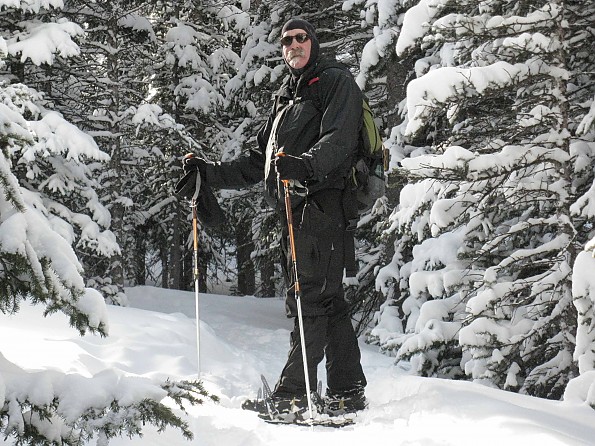
Update: April 3, 2011
Well this is the third review on the Lightning Ascent. I made a mistake on the first two reviews as that shoe was the MSR Axis.. still a shoe i would shy away from..
Now on to the Lightning Ascent. wWell, not happy, the rubber decking is tearing on both the right and the left shoe. on the outside, probably due to the stress from walking at an angle to the slope and the pressure from my weight.. 255..
Paid a buttload of cash, probaly should have gone for the EVO. damn I hate wasting money, and then when you go to the website.. under warranty repair..
What is not covered
Normal wear, abrasion, misuse, alteration, abuse, taking apart of the product, or improper washing and drying are not covered. This warranty does not cover damage caused by improper care, accidents, prolonged UV exposure, or the natural breakdown of certain materials over long periods of time. Cascade Designs will not be liable for incidental or consequential damages. Some states do not allow the exclusion or limitation of incidental or consequential damages, so the above limitation may not apply. Shipping charges to Cascade Designs for a defective product are not covered.
Makes you wonder what is covered????? 5 treks.. torn rubber decking.. arg..
Price Paid: too much for what they are worth
I have had a pair of the men's 25 inch lightning ascents for over two years now. They are, in my mind, the best snowshoes money can by.
Mine are the model previous to what is on the store shelves as of December of 2010. Please keep in mind my review reflects that fact and does not reflect the new model (although the new model upgrades would probably increase my rating to a 5).
These snowshoes grip and grip well. I have been on numerous group outings and it really gives me perspective when I can easily go uphill, downhill and sidehill with ease. While others, wearing slip and slide, especially those with snowshoes whose frames are tubular. Proper technique and physical abilities of a snowshoer are always paramount, these snowshoes will take you to your max potential.
Pros: Lightweight (surprisingly the same or less than others), the BEST traction, intuitive and calf-saving heel bar for uphill, bulletproof and easy to use bindings, very-very durable construction, very field maintainable with a repair kit purchased at almost any store that sells MSR snowshoes.
Cons: No ability to use flotation tails (new models DO have this ability), plastic clips to hold excess binding straps (although you can trim them at home to reduce the excess and the new model has metal rivet style clips), and as mentioned in a previous review use of gaiters is a good idea (but the are almost always necessary for snowshoeing anyhow).
I am 6'8" 235lbs.(close to 265lbs with all my gear) and as noted use the 25 inch models. On everything but the most groomed/packed trails I do experience a moderate to heavy sinking (varies greatly on the composition of the snow/layers). But, using 30inch snowshoes all the time is such a pain.
I was really pleased to see that the new model is capable of accepting a 5inch flotation tail, making a 25inch snowshoe a 30inch one when you need it. Versatility. Isn't that what makes a happy consumer.
I think I will make myself wait one more year before buying the new model (who has the money to go out and buy a new pair every year or even every couple of years these days).
In conclusion the MSR Lightning Ascent are the best snowshoes your money can buy. As a side note MSR also came out with very similar model called the Lightning "Axis" this year which the only difference is the bindings (one pre-set strap over the top of the foot versus 3 for the lightning ascent). Now, I for one am much more comfortable having 3 straps instead of one. Call me superstitious.
Price Paid: $270
Solid, adaptable, compact, and good traction.
Pros
- Solidly made
- Compact size and lightweight
- Excellent traction on all angles
- Easy on/off
- Heel televator
Cons
- Sometimes hard to get heel strap on tight/fast
I used a pair of 30" Sherpa tubular frame/neoprene base/lacing shoes for many years. Sherpa had an excellent warranty for lacing replacements, and even gave me a discount on a new pair when my original ones finally gave out. When the lacing/base on those gave in, it was time to try something new.
Got the 25" MSR Ascents a couple of years ago on sale. Vertically oriented metal framing to which a nice neoprene base is attached/riveted. No lacing. Aggressive crampon under the hinge.
Generally they are quick and easy to get into and out of. On occasion I have found it hard to get the heal strap on tight/fast, since I can't see what I'm doing back there very well. Practice helps.
The shoes provide generally good floatation, and especially good traction due to the vertical frame structure and crampon. Coupled with the televator, ascents are less of a struggle than with the old Sherpas.
Very pleased with them. Recommended for typical conditions here in the Pacific Northwest.
Source: bought it new
Price Paid: $200
These are tough, high quality, lightweight snowshoes with excellent floatation.
Pros
- light weight
- aggressive
Cons
- binding pins
- expensive
My first pair of MSRs were the high impact plastic Denalis. The Lightning Ascents seriously feel like they weigh less than half what the Denalis did. The heel lifter is a huge benefit when headed up a steep incline and the serrated edges provide more than adequate traction in any conditions.
I've used the Ascents for two seasons now, and my only beef is related to the binding. The strap lock on the Denalis uses a hook that the strap is pulled over and held in place with tension. Unfortunately, MSR must have decided they could improve on perfection and created the strap lock on the Ascents using a pin that you have to push through the hole in the strap. Cold temperatures and cold fingers make locking the strap in place more of a workout than your entire day snowshoeing.
Finally, the Lightning Ascents are just about the most expensive commercial shoe out there, so price might be an issue for some folks.
Source: received it as a personal gift
I think the review that gave these zero stars smells of pilot error. Walking downhill on ice with snowshoes takes a little practice (like walking downhill in crampons) and snowshoes do not miraculously provide levitation. 250lbs with a pack and you should have been on at least 30" snowshoes - possibly even larger depending on the shoe.
The Lightnings are the sweetest thing happening in snowshoes. I have worn and sold every brand's "top end" model out there and these are the lightest, most efficient shoes I've ever worn.
After swearing them off for skis years ago, a recent approach to an ice climb forced me to try them out again. I was blown away. Primarily - you can traverse a crusty snow - which you encounter far more than powder! I can still remember a trip with Atlas shoes in Colorado where I almost threw them into the forest as I slid into tree wells on a long traverse. Round edges simply don't 'cut it'.
I'd still rather ski approach any day but if I have to wear snowshoes, I no longer guess what to wear.
Price Paid: $275
I've owned these snowshoes for five years and the binding (made of very hard but brittle material) has now cracked in multiple places on both bindings making my $280 pair of snowshoes worthless.
Pros
- Great traction
Cons
- Bindings will crack at the rivet points making them worthless
- MSR does not respond to emails (4 of them)
- No replacement parts available.
- $280 bye bye
Bindings will break at the rivet points after ~100 - 150 miles.
You'll need to get new snowshoes since MSR does not respond to communications.
I'd suggest Faber Mountain Masters, a much superior design and binding system.
Source: bought it new
Price Paid: $280
This is not for deep snow backpacking. I could not get up the Canyon's North Rim as I sank up to my chest. Not a great way to discover an inadequacy. I was 25 pounds below the max weight listed for them.
Pros
- The lifter on the back was wonderful
- Lightweight
Cons
- Not much different from postholing with a backpack on
- So light they don't hold you up
- Weight specs are totally wrong
As I said briefly, I am a winter backpacker. My hugely wide old Tubbs weigh 6 pounds and I wanted to lighten up. Boy was that 2 pound savings a huge mistake. I sank deeper and deeper the higher up the canyon I went. Past the Supai Tunnel I went to my chest and had to turn around.
My old Tubbs have never sunken deeper than one foot. It was shocking as I got the 25-inch ones and was 25 pounds from the max. so I reasonably expected these to carry me appropriately. I guess if you are going a day hike and 75 pounds from the max you will be OK and happy with them.
As for me these will be returned and my 25-year-old heavy Tubbs brought out of retirement!
Source: bought it new
Great snowshoe in all conditions.
Pros
- Excellent traction
- Light weight
- Adequate float
- Binding stays put
Cons
- Slapping sound from decking on hard pack.
I really like these snowshoes, they have awesome traction and float. I have the 25" ones and used them up Algonquin and Wright Peak the other day in the Adirondacks and experienced everything from hard pack, to ice, to soft but heavy powder. They were great in all conditions.
I can see needing the flotation tails in fluffy fresh powder for additional float, but in the heavier spring stuff they were great. Traction on hard pack and ice is as good as a crampon and they are lightweight and easily maneuvered. The binding system is simple yet stays put and is easy to adjust.
The heel lifters are sweet, they work great and are very easy to pull up. I use Black Diamond poles that have a lip on the top of the grip and it works great with these.
The only downside is that the material the decking is made out of makes a slapping noise as they hit your heels on hard pack, with any sort of soft snow they don't seem to do this. Kinda like a huge flip-flop.
Source: bought it new
Price Paid: $107 on Amazon
I love these snowshoes! Lightweight with great traction! Will go through anything!
Pros
- Great traction
- Great fit
- Lightweight
- Great for climbing
Cons
- None
These snowshoes were a great buy! Got them on Amazon before Christmas when there were awesome sales going on. Paid $199; I think they retail for $279?
I'm very happy with them. Very durable with great fit and traction, will go through any winter terrain, and great for climbing in the snow.
Source: bought it new
Price Paid: $199
I bought my Lightning Ascents a bit over a year ago. At that time, the binding used two straps over the top of your boot; they have upgraded it this year to three straps over the top of the boot.
And that may solve what I found to be the key problem: my boot drifted in the binding.
Overall, I agree with the other reviewers about its traction, light weight, the value of the ascent bar, and its generally strong performance. But the foot drift was an annoying problem.
I think MSR probably changed the binding in response to the problem I and others encountered. I have used the same three-strap binding on other MSRs (the Denali Ascent), and it has been very satisfactory.
So, while I would rate my two-strap Lightning Ascents at three stars, my guess is that the three-strap model would deserve four or five stars.
I've had the opportunity to use a variety of snowshoes in the mountains of BC including Atlas, Tubbs, and two MSR models. I was all set to purchase the new MSR Evo Tours, but the Lightning Ascents landed in my lap for the same price.
I love the grip, as I found out today that you can climb the steepest of steeps with the ease of climbing you stairs at home. Their light weight, quick and easy three strap system, and heel bar make them worth every penny.
The major selling point for myself is the hinge system of the crampon doesn't allow the shoes' body to float around and kick you in the calves like most of the suspended style systems do.
I've talked to a variety of users on the trail that have them and have never heard a complaint.
Price Paid: $200
I was able to test these shoes this morning after a good October snowstorm. I was very impressed with the performance. The bindings were easy to get in and out of, and they stayed as tight as I needed them to. I was making first tracks through fairly light Utah powder and the snow shoes stayed on top very easily. I headed up steeper terrain to test the climbing ability of the shoe and it performed as advertised. The shoes were lightweight and felt great under your feet. I look forward to many more miles on these. If you are looking for a shoe to put around packed trails, this might be too much shoe, but if you are looking to get to some steep backcountry terrain this might be the shoe for you.
Price Paid: $144
The MSR Lightning Ascents were the second style I've used and followed the tubing style I started on. They were night and day stable. On my first hill climb I forgot the heel bar for a few hundred feet. What a difference it made. It was like climbing stairs with it up in place.
I also noticed and appreciate the stability afforded on the traverse on slopes. The heel doesn't move compared to a standard shoe and binding. The only glissading I experienced was steep downhill in a couple feet of powder and it was a controlled downhill jog. Never had any strap issues as far as loosening up but one did break. Sold the family on these and anyone I've let test out.
Price Paid: gift
I used those in the mountains of Quebec, and it was amazing; they look like they're not going to support you in the snow because they are narrow, but hell, it's perfect in 10 feet of snow.
I moved to Vancouver and went off-trails with them, in a lot of snow on flat or very steep, climbing rocks, it all goes, perfectly. What I do in this hardcore snowshoeing-hiking country, is called "crazy", I call it heaven.
If you are an off-trails, on-trails, lots of snow or not, steep condition or not, this is the top of the line.
Price Paid: 250 CDN
I did a fair amount of 'field testing' rental snowshoes before settling on the MSR Lightning. You can usually count on a various mix of trail conditions in a typical Northeast winter climb, ice, packed snow, waist deep powder. With the exception of 'wanting to glissade' in these shoes (which doesn't happen with the traction they afford you) there isn't much bad you say about the shoes. Late spring slush hikes can throw quite a bit of water onto your calves, so keep the gaiters handy. They are light, offer unbelievable traction and pack well.
The binding rubber becomes inelastic below 10 F. The two front binder straps continually release - usually after the plastic keep breaks.
All straps must be taped at the dead end or they will spontaneously leave the shoe at some point.
The two strapper requires so much pressure to keep boot centered that only plastic boots can be worn for long periods.
Edge teeth have ripped my Patagonia Guide Pants twice so it is advise to wear gaiter with these shoes.
Otherwise, a great platform.
Binding needs tweaking.
Great shoes! Got the 25's and they can handle all conditions. Agree with the below comments.
One downside is that the 25's with the tail extensions may keel you forward a little bit in softer, deeper snow (15+ in.) because of the smaller toe. Opting for the 30's is better in this case because the front is proportionally larger.
Crampon frame and heel lift = straight up ANY hill.
Source: bought it new
Price Paid: $230 CAN.
I bought them last year '07, used them 6 times. Snow was always hard. They slid on ice going downhill. This year first time out lots of fresh snow sinking 16-24 inches, thought I might be spending the night.
I am new to this 6' 3" and with gear 250 lbs. Sales person said they would do the trick, and MSR also rated them for 225+ lbs.
I am now looking for a new pair. Anyone know of a brand and style that will do the job?
Price Paid: $300
Wonderful shoes, lightweight, low profile, easy to get in, go anywhere and the kicker, they're orange :)
Your Review
Where to Buy
You May Like
The Lightning Ascent replaced the MSR Lightning Axis.
Accessories: MSR Lightning Tails,
Specs
| Men's | ||||
|---|---|---|---|---|
| 22 in | 25 in | 30 in | ||
| Price |
MSRP: $319.95 Current Retail: $389.95 Historic Range: $144.83-$389.95 Reviewers Paid: $107.00-$300.00 |
|||
| Weight per pair | 4 lbs 2 oz / 1.89 kg | 4 lbs 5 oz / 1.97 kg | 4 lbs 14 oz / 2.24 kg | |
| Width |
8 in / 20 cm |
|||
| Load | Up to 180 lbs / 80 kilos | 120-220 lbs / 54-100+ kilos | 150-280 lbs / 68-127+ kilos | |
| Load with tails | Up to 250 lbs / 114 kilos | Up to 280 lbs / 54-127 kilos | 180-300+ lbs / 82-136+ kilos | |
| Frame material |
7075-T6 Aluminum |
|||
| Deck material |
TPU coated nylon |
|||
| Women's | |||
|---|---|---|---|
| 22 in | 25 in | ||
| Price |
MSRP: $319.95 Current Retail: $292.46-$389.95 Historic Range: $144.83-$389.95 Reviewers Paid: $199.00 |
||
| Weight per pair | 3 lbs 14 oz / 1.76 kg | 4 lbs / 1.83 kg | |
| Width |
7.25 in / 18 cm |
||
| Load | Up to 180 lbs / 80 kilos | 120-210 lbs / 54-95 kilos | |
| Load with tails | Up to 240 lbs / 109 kilo | Up to 270 lbs / 54-123 kilos | |
| Frame material |
7075-T6 Aluminum |
||
| Deck material |
TPU coated Nylon |
||


